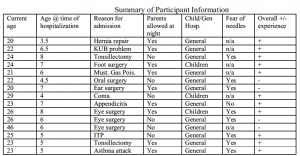Katie Johnson and Dr. Barbara Mandleco, College of Nursing
In an effort to improve nursing practice with children, this study looked at the long-term effects and memories of childhood hospitalization on adults. In young children, common behavioral changes observed include; initial aloofness toward parents followed by dependency behaviors, nightmares or new fears, resistance to going to bed and waking up during the night, withdrawal, shyness, etc. (Wong & Perry, 1998). These behaviors though temporarily displayed, may have long-term consequences. For example, the hospitalization may ultimately lead to the individual experiencing difficulty with strange environments, forming attachments with peers, and maintaining relationships. On the other hand, this stressful environment can lead to the child developing positive coping strategies towards stress that may in fact have a beneficial effect on them in their future. This particular study investigated the questions of whether or not childhood hospitalization has long-term effects, and if those effects are beneficial or detrimental; how nurses contribute to the positive or negative outcome the patient experiences; and what the differences of general hospitals and children’s hospitals are. With the results, nurses and hospitals can integrate findings into their own interventions to improve their care to children.
A total of 14 participants for the project responded to advertisements to be a part of this research study. There were 7 females and 7 males. Participants ranged from 20 to 46 with a mean age of 25 currently and a mean age of 6 at the time of hospitalization. Their length of stay varied from one day to two weeks with a mean of 4 days spent at the hospital, although 5 of the 14 had multiple hospital stays. Three out of the 14 (21%) participants spent time in a children’s hospital rather than a general hospital. Of the three, two had also spent time in a general hospital on separate occasions.
After responding to advertisements participants agreed to meet at a mutually agreeable public location and time. Before the interviewing process began, participants signed an informed consent. Interviews were tape recorded, transcribed, and analyzed. Analysis of the data provides strong evidence that children’s hospitals provide greater support to the pediatric patient and that when general hospitals integrate similar interventions the patient’s perception improves.
Beginning this research project, I hypothesized that nurses significantly influence the long-term effects that children have and that children are in fact impacted by hospitalization. In my summation of the transcriptions I found that most children perceived their nurses very positively and therefore reported having a good memory of their experience. Many saw their nurse in the role of their mother. However, in the cases where the children felt the nurses were rushed, inconvenienced by them, or treated like an adult instead of a child, negative memories dominated and instead of their fears being eased they were exacerbated. Traits that distinguished a caring nurse from a rushed nurse included explaining procedures to them; playing games with them; talking to them; reassuring them that they would be okay; distracting them; feeling pampered; getting candy, stuffed animals, and awards; and being cheerful.
Long-term consequences evident in the sample population include having difficulty trusting, fear of hospitals, fear of needles, and loss of memories of experience that have been regained through recent exposure to similar smells from child hood experience. Positive outcomes include a greater feeling of love and support from family, increased trust, increased meaning in life, and increased ability to deal with challenges that arise in life.
Significant differences from children and general hospitals were the warmth of the environment, the friendliness of the staff, the amount of children’s activities available, and the expertise of healthcare workers in dealing with children. More specifically procedures like starting an IV differed. In the general hospital, the child received no local anesthetic and in the children’s hospital they remembered receiving local anesthetic first and having the procedure explained to them in terms they understood.
As a result of this study I feel that it validates the increased funds on improving pediatric environments in children’s hospitals and especially general hospitals since the majority of children will go to general hospitals when seeking healthcare. It is important for practicing nurses to realize their impact on the experience children have and the importance of treating a child as a child. Children remember how they felt in their situation and almost all wished they had more information about their situation. Another major impact on children was whether or not their parents were present. This particular factor effected their stress level and ability to cooperate with the hospital staff.
Reference
- Wong D L, Perry S E. (1998) Effects of hospitalization on the child, Maternal Child Nursing Care: 1203-1204.

